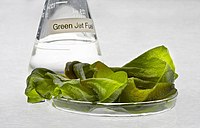
Photo from wikipedia
This study assessed the feasibility of an NMR metabolomics approach coupled to multivariate data analysis to monitor the naturally present or stresses-elicited metabolites from a long-term (>170 days) culture of… Click to show full abstract
This study assessed the feasibility of an NMR metabolomics approach coupled to multivariate data analysis to monitor the naturally present or stresses-elicited metabolites from a long-term (>170 days) culture of the dinoflagellate marine microalgae Amphidinium carterae grown in a fiberglass paddlewheel-driven raceway photobioreactor. Metabolic contents, in particular, in two members of the amphidinol family, amphidinol A and its 7-sulfate derivative amphidinol B (referred as APDs), and other compounds of interest (fatty acids, carotenoids, oxylipins, etc.) were evaluated by altering concentration levels of the f/2 medium nutrients and daily mean irradiance. Operating with a 24 h sinusoidal light cycle allowed a 3-fold increase in APD production, which was also detected by an increase in hemolytic activity of the methanolic extract of A. carterae biomass. The presence of APDs was consistent with the antitumoral activity measured in the methanolic extracts of the biomass. Increased daily irradiance was accompanied by a general decrease in pigments and an increase in SFAs (saturated fatty acids), MUFAs (monounsaturated fatty acids), and DHA (docosahexaenoic acid), while increased nutrient availability lead to an increase in sugar, amino acid, and PUFA ω-3 contents and pigments and a decrease in SFAs and MUFAs. NMR-based metabolomics is shown to be a fast and suitable method to accompany the production of APD and bioactive compounds without the need of tedious isolation methods and bioassays. The two APD compounds were chemically identified by spectroscopic NMR and spectrometric ESI-IT MS (electrospray ionization ion trap mass spectrometry) and ESI-TOF MS (ESI time-of-flight mass spectrometry) methods.
Journal Title: Journal of agricultural and food chemistry
Year Published: 2019
Link to full text (if available)
Share on Social Media: Sign Up to like & get
recommendations!